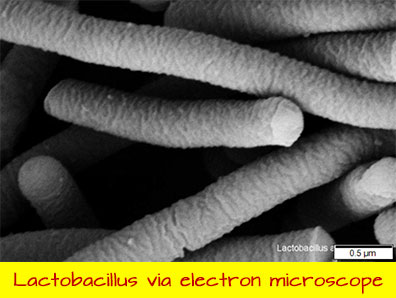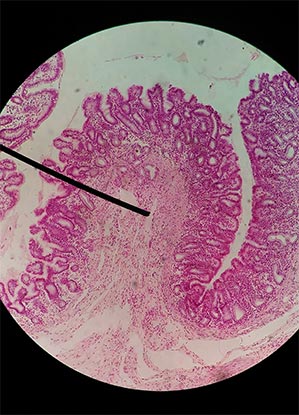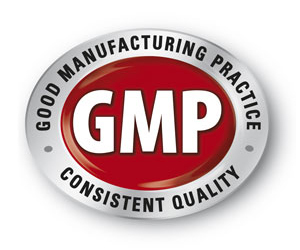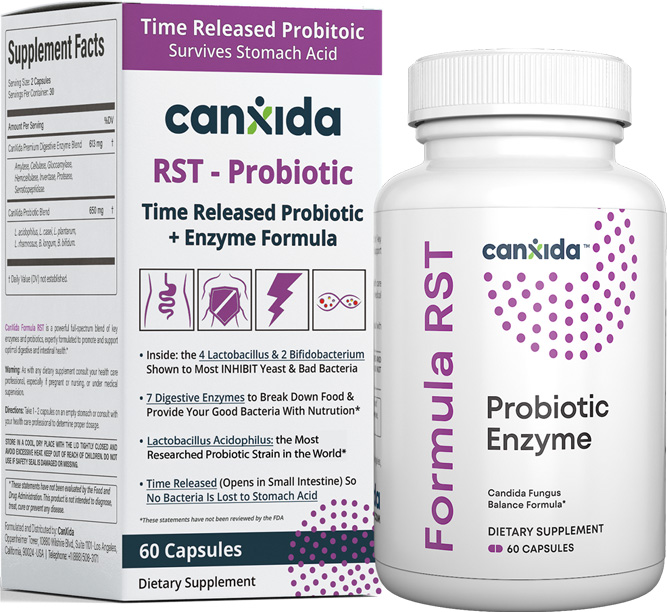Below are the 5 things you want to look for when choosing a probiotic for a severe gut disorder.
1. Is the Formula Centered Around Good Bacteria Strains Scientifically Proven to Inhibit Gut Pathogens?
If you’ve ever compared different probiotic formulas before you’ve no doubt noticed that there’s lots of different bacteria strains out there and some products contain more strains than others.
Some products contain 50 strains. Others contain 20. Most of these are just there for marketing purposes to make you think you’re getting “lots of stuff.” They don’t do anything at all to inhibit yeast or bad bacteria & they do nothing against chronic gut disorders.
The 6 strains that do help with gut disorders are:
- Lactobacillus acidophilus
- Lactobacillus casei
- Lactobacillus plantarum
- Lactobacillus rhamnosus
- Bifidobacterium bifidum
- Bifidobacterium longum
You’ve probably heard of lactobacillus and bifidobacterium as they’re the most researched probiotic strains out there. What most people don’t understand is these strains are the #1 natural enemy of yeast, bad bacteria and parasites.
They’re the #1 competitor of pathogens in the gut. Countless studies show yeast, bad bacteria & parasites can’t grow in areas with high levels of lactobacillus & bifidobacterium.
There’s lots of reasons for this.
L. acidophilus releases lactic acid which interferes with the metabolic process of wide variety of yeast, bad bacteria & parasites. It causes them to have a stress response & stops them from multiplying.
It’s also naturally antifungal.
Lactic acid is the reason why the small intestine has a low pH. Yeast & bad bacteria hate lactic acid and actually have mechanisms that prevent the acidification of its environment. But a probiotic with high levels of L. acidophilus will overload this.
Other antimicrobial agents created by the Lacobacillus species listed above include hydrogen peroxide (which also protects your gut from bad bacteria infections) & special molecules called bacteriocins & biosurfactants.
Bacteriocins are tiny protein-like molecules that slow the growth of fungi, bad bacteria and parasites.
While biosurfactants are molecules that interfere with gut pathogen’s ability to latch onto the gut wall.
Studies show when high levels of Lactobacillus is released into an environment colonized by yeast & bad bacteria, the good bacteria will literally unhook “bad guys” from the epithedial cells that line the gut wall.
We can go on & talk about how these strains also stop hyphae (long tubes Candida uses to penetrate the gut wall and spread to other parts of the body) formation & causes yeast to stay in its less invasive form.
Or how they amplify the effect of antifungal medicine by increasing the permeability of the fungal membrane (a fancy way of saying they make tiny holes in candida’s cell wall so antifungals can get in easily).
But we think you get the point.
You don’t need to understand all of these scientific terms.
Just understand that “bad guys” HATE these 6 strains. They compete with yeast & bad bacteria for food, nutrients, colonization space, “poison” them by releasing molecules that prevent its growth, & will even “evict” them from their “home” & send them packing.
They also have additional benefits such as in the case of Lactobacillus casei.
Casei is very important when you’ve got gut issues. Why? Because it mops up immune debris & waste particles (toxins) created by yeast & bad bacteria that leak through the gut & lodge themselves throughout your body.

It stops them from getting into your bloodstream, causing inflammation & making you feel sick.
This allows your immune system to focus more on the big issues (like cleaning up your gut).
It also helps with food allergies because it trains your immune system to relax and not be hyper-reactive.
These are the strains that are most responsible for fixing your gut environment. The list above includes the 4 best Lactobacillus and the 2 best Bifidobacterium.
To learn more about these 6 strains, check out the product page for our CanXida Restore (RST) formula which goes over the each of them in more detail. You can get to it by clicking here.
Don’t worry about any other strains. They’re nowhere near as important.
Also remember that only so many probiotics can fit into a capsule. So if a formula has 12 or 20 strains, it’s going to have lower levels of the strains you actually want.
2. Avoid Formulas that Contain Prebiotics or FOS
Prebiotics (also known as FOS or fructooligosaccharides) are a special type of sugar naturally found in foods such as broccoli, coconut and bananas. These sugars are what feed probitoics (beneficial bacteria) and make them grow.
That’s why they’re called prebiotics. So why do we tell you to avoid any probiotic formula that contains them?
Because we’ve seen them cause too many bad reactions when taken in supplement form. Any time a customer tells us they tried a probotic formula in the past and it made them feel sick or bloated or gave them brain fog, we know right away that formula contained prebiotics.
Companies add these sugars in thinking they’re going to feed the beneficial bacteria.
Oh yeah, they feed the bacteria alright. . . They feed everything from the e. coli to the clostridia and all the other bad bacteria that cause bloating and brain fog & make you feel like crap.
Companies will tell you these sugars are from “natural sources” but in reality that “source” is a factory or lab.
We’ve had it with prebiotics. We’ve seen them cause too many aggravations in customers. Get rid of any supplements that have them. You’ll get much better results if you take a probiotic without prebiotics.
It’s fine to eat foods that naturally contain FOS like the ones we mentioned but don’t take supplements that contain them.
3. Does the Probiotic Formula Also Contain Enzymes?
Instead of prebiotics, get a formula that contains digestive enzymes.
Research in the past 7 years has shown that when you take enzymes and probiotics at the same time, you get an amplified effect.
There’s lots of reasons this happens. First, enzymes kick start the gut and improve the acid / alkaline ratio of the stomach and small intestine.
This creates a more favorable environment for the beneficial bacteria to grow. It also creates a hostile environment for the bad bacteria and yeast.
They annoy the bad guys and encourage the good guys & shift your bacteria population from bad to good.
Enzymes also help with the healing process. Many people with gut disorders have damaged or inflamed digestive systems caused by bad bacteria & yeast overgrowth. Enzymes help with this by allowing your gut to heal at a faster rate.
They can also help mop up any garbage that needs cleaning up.
It’s like sweeping a floor that hasn’t been cleaned thoroughly for many years. You might notice that you pass out bowel plaques or mucous. You may have more frequent bowel motions or larger stools.
Enzymes are especially important in the first and second month of the gut healing process because they’re going to break down all the vegetable starches your good bacteria are going to feed on. This is how you feed the good bacteria without feeding the bad.
That’s why you should look for things like amylase, hemicellulase, protease, invertase, and glucocoamylase on probiotics labels.
Because these target all the different kinds of carbohydrates, proteins and fats you’ll need help digesting if your gut isn’t in great shape yet.
Not all enzyme formulas are compatible with probiotics.

So don’t just grab an enzyme supplement from Amazon or iHerb and combine it with whatever probiotics you’ve got laying around.
It takes a special skill that a clinician develops over time to understand how to combine these two successfully so you get an amplified effect like we described.
If you’re taking a probiotic formula right now and you’re not taking enzymes along with it, you’re missing the boat.
You really are. Enzymes make all the difference.
If you want the best possible product, make sure the probiotic + enzyme formula you choose contains an enzyme called serratiopeptidase.
This is a very powerful enzyme that will bind to circulating immune complexes in the blood. That means that once you take it, it will actually start to hunt down little bits of debris in your bloodstream created by bad bacteria and yeast as they die off.
This is particularly important for people suffering from Leaky Gut or auto-immune diseases because this debris is one of the main causes of things like rheumatoid arthritis and joint pain.
As well as brain fog, headaches, and many other symptoms. . .
4. Does the Probiotic Come In a Time-Released Capsule?
Another thing to check for is if the probiotics come in what’s called a time-released capsule.
These capsules are very expensive to manufacture so usually a company will tell you on the label if it’s time-released or not.
These aren’t the cheap cellulose capsules that break down in the stomach.
They survive the stomach and only open up in the small intestine.
That way nothing is lost due to stomach acid. Nearly all probiotics you buy don’t do that. They don’t fully survive the stomach bypass. They actually get destroyed before they get to the intestine.
A time-released capsule is different. It’s not affected by digestion.
5. Is the probiotic GMP Certified or Made in a GMP Certified Facility?

Be VERY vary of any probiotic that doesn’t have a “GMP Certified” seal on the label.
Particularly the cheap probiotics you see on store shelves.
Many years ago before GMP (Good Manufacturing Practices) were enforced on the supplement industry, we spoke with many experts in America and Europe regarding probiotics and how they were made.
And we were quite amazed to discover that when a survey was done on U.S. probiotics just before GMP was enforced, many of them were found to be USELESS and DEAD.
The cheap probiotics had NO VIABLE BACTERIA in them at all — people were just getting ripped off and they had no idea! And we can tell you right now that chances are, especially if you’re buying some “el-cheapo” product at the supermarket or Walmart, you’re probably still getting scammed.
An easy way to tell is to see if the factory or supplier has a GMP certification.
Before you check out other probiotics take a look at our CanXida RST formula.

This is a heavy duty probiotic we designed specifically for people with moderate to severe candida problems who need help fast.
It meets all 5 of the criteria above (including serratiopeptidase).You can learn more about this formula by visiting www.canxida.com/restore.